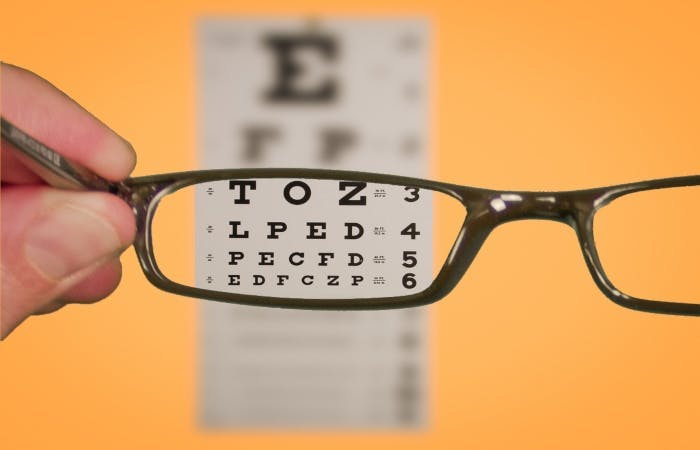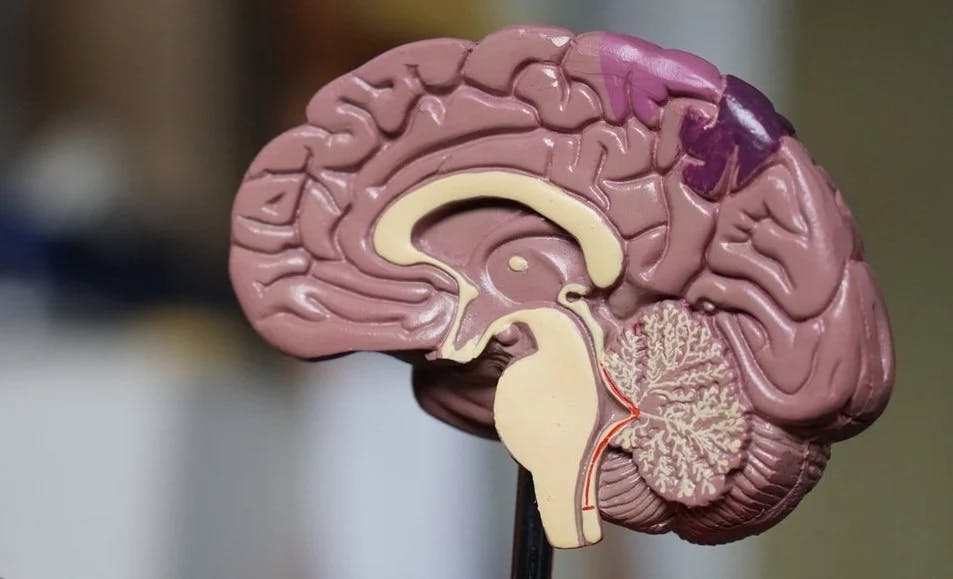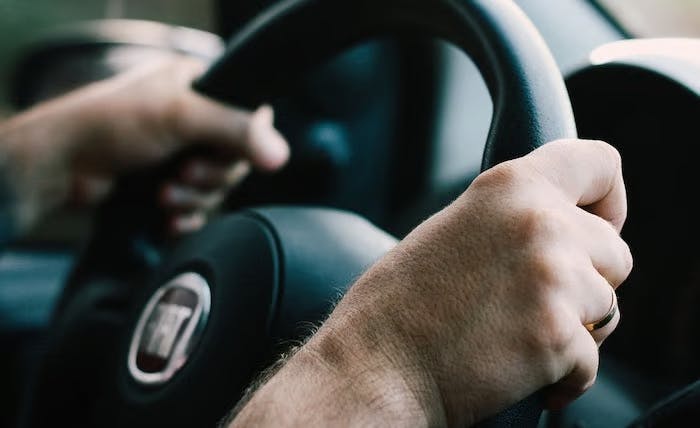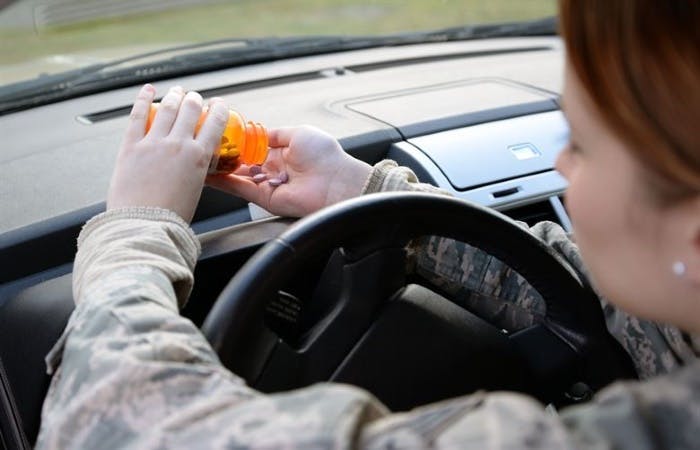
Being a safe driver is not just about developing proficient techniques and good habits. It also relies on being physically and mentally fit enough to be in control of a vehicle in a challenging and varied environment. There are legal requirements to do with vision, manual dexterity, medical conditions, and drug intake—both legal and illegal—and that have to be met in order to be allowed in the driver’s seat.
Here we discuss the bodily, cognitive and emotional factors that all affect your fitness to drive—and what to do if they are impaired in some way. So, whether you're thinking about taking lessons, are a seasoned driver, or a concerned family member or friend, this post will provide you with valuable information to help you stay safe on the road.
Please note: this information relates to car and motorcycle licences only. There are more stringent laws to drive larger vehicles, like buses or HGVs.
Vision

Having good vision is a key requirement of being fit to drive. When behind the wheel, our eyes are one of our most useful tools: we rely on them to see the road, identify road markings and read road signs, as well as to spot potential hazards, such as vehicles, pedestrians, and other obstacles. Any sight impairment, whether that affects your ability to see clearly near, far, or in your peripherals, can therefore affect your ability to drive safely.
The law requires all drivers to be able to read post-2001 number plates from a distance of 20 metres. This is assessed during every practical driving test: before you settle into the driver’s seat, you have to prove that you’re safe to be on the roads at all. Fail, and you’ll have to reapply for your provisional licence before you can book another test: a huge set-back in terms of time and money.
And you’re not in the clear if you’ve already got your licence, either. The police can pull you aside at any time to check your vision—and if it’s not good enough, there’s no slap on the wrist. It’s a revoked licence you’ll face, meaning you can’t legally drive on the roads. Only once your disqualification period has passed can you re-apply for it, alongside proof that you can now see far enough.
Certain eye conditions may need to be reported to the DVLA, but many more won’t. It doesn’t usually matter if you’re one of the many millions of people in the UK without perfect eyesight. In fact, you can even drive if you only have sight in one eye, so long as the vision in the other eye is deemed adequate. Most people are able to correct poor vision through glasses, contact lenses or laser eye surgery, and this is perfectly acceptable for driving. Just be aware that if you do need corrective eyewear to drive, then you must never drive without it.
Hearing

While vision is essential for safe driving, there’s another sense that’s also pretty useful on the roads: hearing. Good hearing alerts drivers to traffic sounds, such as sirens, horns, and other vehicles around them. For example, hearing an emergency siren should forewarn you of an approaching ambulance, police car or fire engine, so you can take appropriate action—like pulling over and allowing the vehicle to pass. Similarly, when another driver beeps their horn, they are usually trying to notify you of their presence or another danger. This could prove crucial in avoiding a collision.
However, while good hearing is useful, it’s not a prerequisite of driving. You can still be fit to drive if you’re D/deaf, or if your hearing is impaired either permanently or temporarily. But it is helpful to be aware of any hearing loss, so you can remain alert to road hazards in other ways. Having your hearing checked regularly, and especially any time you notice a change in your hearing ability, is therefore pretty important. And if you have hearing aids, checking that they’re fully functioning, and wearing them as you drive can be beneficial.
Cognitive function

Cognitive function refers to mental processes. In order to be deemed fit to drive, you must have adequate attention, spatial awareness, decision-making, and reaction time skills. You’ll need to display these throughout your lessons, theory and practical test—but will also find that you’ll have to continue to guard against distractions, even as a more experienced driver. You must tell the DVLA about any cognitive impairment you face.
Attention
Drivers need to pay attention to the road and their surroundings, so that they can perceive potential hazards and act accordingly. Distractions can impede cognitive function, because of their impact on concentration: anything from conversation to daydreaming can take our focus off the roads. As well as setting in place strong boundaries regarding passengers and phones, you can also make sure you’re well rested before setting off and practise defensive driving techniques to keep your mind alert to what’s going on around you.
Spatial awareness
Spatial awareness is a critical cognitive function that allows you to position yourself correctly on the road and judge distances to other traffic or objects. Lots of people struggle with spatial awareness, and while technology like parking sensors can help, there are also ways you can learn to be better at it:
- Think about where your body is, rather than the car. We have a more accurate idea of our body’s position in relation to other things, because we’re much more familiar with moving around in them. When driving, try to keep your left leg in the middle of the lane. Your car will follow suit.
- Focus on the available space, not your own width. For example, try to imagine another car the same size sitting next to the parked vehicle up ahead. If it fits comfortably, so should you.
- Learn the reference points specific to your car. Stop in a safe place and position yourself a sensible distance from the kerb. Identify where it appears at the bottom of your windscreen and use this as a marker for times when you need to park or squeeze through tight gaps.
Decision making
Drivers must be able to make quick and sound decisions in response to changing road conditions or unexpected situations. For example, you may need to decide whether to brake suddenly or speed up to avoid a hazard. This cognitive skill should improve with experience. Make sure you have enough driving lessons to encounter a wide range of road-based scenarios.
Reaction time
Reaction time is also crucial for driving safely. Drivers need to be able to respond quickly and appropriately to emerging hazards, such as a pedestrian stepping out into the road or a car suddenly braking in front of them. The most extreme example of this is something you may have to prove on your practical test, if the examiner asks you to perform an emergency stop.
Be aware that your reflexes may deteriorate with age, which is one reason why drivers over 70 have to renew their licence more frequently. Always travel at least two seconds behind another vehicle, so that you have enough time to react to changes in their speed.
Motor skills

Motor skills refer to the physical abilities required for safe driving. There are an awful lot of actions to perform at any one time when you’re in charge of a car. Not only must you coordinate your hands and feet to steer, accelerate and brake, but you may also have to employ fine motor skills to operate switches, buttons, and other controls in the car, such as adjusting the air conditioning or changing the radio station.
What’s remarkable, though, is that once you’ve acquired many of these skills and practised them again and again, your body will automatically remember how to perform them. This is thanks to muscle memory—a part of your procedural memory, which is responsible for recalling learnt movements unconsciously. What once seemed like an impossible task as a learner driver, will become second nature as a seasoned motorist.
However, certain medical conditions or medications can affect your motor skills, and, depending on the severity, may impair your ability to drive safely. You may need to take appropriate measures, such as adapting your car or using assistive devices to make it easier to drive. For example, a driver with arthritis may benefit from a car with power steering and brakes, or using a steering wheel cover to make it easier to grip the wheel.
One common condition, which can affect coordination, is dyspraxia. Most people with dyspraxia are able to pass their tests and become good drivers—but may find it more of a challenge to coordinate their hands and feet, especially during the early days of driving. One option is to choose to learn in an automatic car. This reduces the number of actions you have to perform all at once; rather than getting to grips with gear changes and clutch control, you can use that energy to focus on other essential motor skills you’ll need instead.
Medical conditions
The DVLA doesn’t care much if you catch a common cold, but there are over 100 medical conditions that can be notifiable. In other words, you may be required to tell the DVLA about them, depending on their nature and severity. The agency can then gather the appropriate information, from you and experts, such as your doctors, in order to make an informed decision about your fitness to drive.
There are a number of different outcomes to telling the DVLA about your condition. You may be able to continue driving as before. You could be granted a licence with a shorter expiry date (one-three years, say, rather than the usual 10), and have conditions placed upon it. Or you might have your licence revoked temporarily or permanently. However frustrating this can be, it’s better than the alternative: the risks of an unfit driver on the road have to outweigh your individual convenience. Need any more persuasion? If you are found to have withheld relevant medical information, your insurance can be invalidated, and you can be prosecuted, fined, and have your vehicle seized.
If you have a disability, you might need a physical assessment before being allowed to drive. It’s also worth looking into funding options and any vehicle modifications that would make your journeys that bit more accessible.
Epilepsy
Many people with epilepsy are allowed to drive—but there are strict rules governing the length of time since you last experienced a seizure, the types of ‘permitted’ seizures you can have without informing the DVLA, and whether you are stable on your current medication. You must also adhere to medical advice, such as taking your drugs and attending check-ups.
In order to get your driving licence, you must usually be able to show that:
- Your first seizure was more than 12 months ago
- Your most recent seizure was more than 12 months ago
The exception is if you had what was deemed a one-off seizure, in which case you may be able to drive after six months.
Talk to your doctor about your fitness to drive. They will be able to give you a better idea of whether the DVLA will grant you a licence—and will tell you if you need to stop driving for a period of time following a change to your medication.
ADHD
Growing awareness of Attentive Deficit Hyperactive Disorder has led to an increase in diagnoses over the last few years. Most people with the condition are safe to drive, and won’t need to inform the DVLA. If you feel, however, that your ADHD or any medication you take for it affects your ability to drive safely, then it becomes notifiable. Talk to your doctor if you’re not sure.
Everyone with ADHD is unique, but will tend to experience either issues with concentration, a tendency to take risks, or both. But there are several strategies you can employ to help you stay safe on the roads:
- Be aware of your symptoms. This will help you find ways to mitigate any risks, such as by using a sat nav that alerts you when you’re driving too fast.
- Take breaks. There’s a lot of processing to be done when driving, and you may find yourself becoming bored or tired quite quickly.
- Find an appropriate level of noise. For some, total silence may be the best way to concentrate. Others prefer a low-level of background noise. Find what works best for you so you can focus on the job at hand.
Diabetes
Managed properly, through diet, medication, or a combination of the two, diabetes doesn’t usually affect your fitness to drive. However, if you take insulin or other tablets for longer than three months, you will probably have to inform the DVLA.
There are certain conditions you’ll face as a driver with diabetes. If you regularly check your blood glucose levels to help manage the condition, you will always have to do so within two hours of taking to the roads—and every two hours after that, if you’re on a long journey. Keep evidence of your readings, as you’ll need to prove you were safe to drive if you are involved in an accident.
You must not take to the roads if your sugar levels are too low, or if you are experiencing symptoms of a hypo—so it’s always wise to keep snacks to hand. And if you experience symptoms when you’re driving, stop, treat them, then wait a full 45 minutes after your blood glucose has returned to at least 5mmol/l before setting off again. This is the length of time it takes for your concentration levels to become normal.
Alcohol and drug use

Driving under the influence is a key barrier to fitness to drive. Drugs and alcohol affect your cognition: they impair your ability to judge situations and respond suitably. Alcohol, for instance, is well known to both reduce your inhibitions—making you more likely to display risky behaviour—and slow down your reactions: a dangerous mix. Even being aware of your impairment doesn’t help in this case—you might end up driving too slowly, or focusing on the wrong things.
Police can pull over anyone they suspect of driving under the influence, as well as conducting random spot checks. Breathalysers and field impairment assessments, which test your balance, will help them decide on the next course of action.
And, even though you’re not meant to take them at all, illegal drugs now also have limits for drivers. That way, police don’t have to prove you’re impaired; the tests will speak for themselves. You may have to consent to a blood test or urine sample, but common drugs such as cannabis and cocaine can also show up on saliva swabs that can be administered at the roadside. And it’s no good refusing to be tested: that’s usually an indication you have something to hide, and is an automatic invitation to be arrested.
Planning ahead is the most effective way of avoiding driving under the influence. There are lots of alternatives: public transport, private taxi or using a designated driver are all options to consider. And, however bad the peer pressure, never accept a lift from someone you suspect to be under the influence, or be persuaded to take the wheel yourself. Risking a couple of minutes of taunting is far better than risking your life.
Driving the morning after drinking
Many drivers wrongly believe that they will be safe to hit the roads after a good night's sleep, but that is not always the case. It takes quite a while for your liver to process alcohol—which remains in your bloodstream for roughly an hour per unit. Since even small amounts of booze can impair your driving ability, you need to be aware of:
- How much you drank, and
- What time you stopped drinking
Play it safe. Remember, feeling sober and being sober aren’t the same thing—so a cold shower, fry up or fresh air might help your head, but not your fitness to drive. The only way to make sure you’re legal is to wait it out—and you could always invest in a breathalyser if you want extra reassurance.
Medications

Illicit substances are one thing, but there are also rules about the legal limits of legitimate medication allowed in your system when you drive. These were introduced predominantly to crack down on misuse of prescription drugs, such as those containing morphine, amphetamines, or methadone. If, on the other hand, you have a valid prescription, and have taken the medication as instructed, then you’re usually allowed to drive, even if the amount in your bloodstream is above the legal limit.
The exception is if you are impaired in some way. Some prescription drugs can slow down your reactions and decision-making ability, cause dizziness, blurred vision or affect your concentration. All of these side effects make it more difficult to operate a vehicle safely, leaving you unfit to drive. There are harsh punishments for drug drivers—including those impaired due to prescription meds: you could face a driving ban of at least a year, an unlimited fine and prison time.
You should always avoid driving if your medication makes you feel impaired—even if there’s no warning on the label to ‘avoid operating machinery’. Consult your doctor or pharmacist if you are unsure about how your medication could affect your driving. In some cases, they may be able to adjust the dosage or times at which you take it to help you avoid drowsiness or other side effects that leave you unfit to get behind the wheel. And it’s always worth asking about alternative medications that may not have the same side effects.
Emotional state

Fitness to drive doesn’t just rely on physical factors, but also on your innermost feelings. Strong emotions, whether negative—such as anger or fear—or positive—excitement, for instance—can act as a huge distraction, seriously affecting your ability to concentrate. Your heart rate rises, and your body has to use extra energy to stabilise your mood.
So wrapped up in our own heads can we be, that we might display poor decision making, attempt risky manoeuvres or drive at an inappropriate speed. At this point, the safest thing to do is not drive at all. Taking deep breaths can help regulate your heartbeat and calm your nervous system, to a point where you are no longer overwhelmed by emotions.
Road rage
It often begins as a small irritation: a failure to say thank you; a car getting too close behind; some misjudged timing, leading to you having to apply the brakes. But, and it happens far more easily than it would in other real-world situations, that feeling can soon turn into action. Perhaps, just as online, there’s a feeling of anonymity when encased in a car. Honking, gesturing, or shouting at other drivers doesn’t feel particularly personal.
But even small actions can escalate—and the consequences of road rage can be severe and far-reaching. When drivers experience it, they may become aggressive, impatient, or reckless, which can lead to engaging in dangerous behaviour of their own. All of a sudden, that’s another motorist speeding, tailgating, or cutting up others. The cycle continues.
If you notice yourself prone to raging on the road, then avoiding stress by giving yourself plenty of time to reach your destination and eschewing rush hour traffic where possible, may help. But, whatever steps you take, there will always be situations that could trigger you. Managing your own emotions when driving is therefore crucial to avoiding aggressive or provocative behaviour.
This involves a change in attitude. Acknowledge your own lack of control over other bad drivers, apply a little empathy to someone who’s made a mistake and focus on the present, rather than dwelling on the actions of someone else two minutes ago. Put things into perspective and a frustrating moment on the roads can remain just that—no escalation needed.
Am I fit to drive? Summary
Being vigilant about your health is just as important as learning the right skills to employ in different driving scenarios. Ultimately, it’s about keeping yourself and other road users safe—by making sure you are physically and mentally well enough to take charge of a vehicle.
Once you’re sure you’re fit to drive, we can help you with the rest. Choose a course or give us a call on 0333 123 4949 to discuss your options today.
Fitness to drive FAQs
Q. Who decides if a person is fit to drive?
A. The DVLA holds the ultimate authority in determining whether or not someone is fit to drive. However, your doctor also has a responsibility to ensure that their patients have a good understanding of their medical conditions, which includes advice about whether they face impairment to being a safe driver. In some cases, they may have to inform the DVLA if someone is unfit to get behind the wheel.
You as the driver are culpable for your own behaviour though—so if your intake of alcohol, illegal drugs or prescribed medication doesn’t fit within safe driving laws, you can face legal repercussions. And if you have a notifiable medical condition, it’s on you to tell the DVLA.
Q. What is a fitness to drive test?
A. If you have a medical condition or disability, you may be advised to undergo a driving assessment at a Driving Mobility Centre. This will involve both a medical examination and a practical driving session. You can also self-refer to the service to get a better understanding of your fitness to drive, and any car adaptations that may help.
Medical professionals use official guidelines to assess and advise on whether someone is fit to drive. They will look at different aspects of your condition, as well as whether you take any medication as prescribed, to make an informed judgment. The DVLA says that anyone with a condition that’s at high risk (20% or above) of causing of a sudden disabling event won’t be allowed to drive.
Q. What medical conditions need to be declared to DVLA?
A. There are over 100 medical conditions which you may be required to tell the DVLA about, including diabetes, strokes, heart conditions, epilepsy and glaucoma. The guidelines differ for each condition: some you always report to the DVLA, and others are notifiable only if they—or the medication you take for them—affect your ability to drive.
If you are yet to get your provisional licence, you must include the relevant information in your application. Bear in mind that you will probably be waiting longer than usual to receive your provisional if this is the case, while the DVLA determine your fitness to drive.
If you already hold a full licence and develop a notifiable condition, you must let the DVLA know through the government website. You’ll be told if you need to report your condition through a paper form instead.
Subscribe for driving advice, offers & more
We'd love to let you know about our courses, news and offers via email. You may unsubscribe at any time.
Star Genie Limited trading as PassMeFast. Company number 10093359
Copyright © 2024 owned by Star Genie Limited
PassMeFast, Blue Tower, MediaCityUK, Salford, M50 2ST
